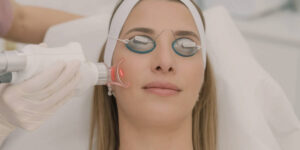Laser Vein Treatment
Step into the realm of advanced aesthetics with our Nd:YAG Laser Vein Treatment, designed to address a variety of visible veins with precision and finesse. This cutting-edge procedure effectively targets:
- Spider Veins: These small, dilated blood vessels visible on the legs and face can be significantly reduced, leaving your skin smoother and more even-looking.
- Reticular Veins: Slightly larger and often appearing blue or green, our precise laser energy diminishes their visibility for a more harmonious complexion.
The laser’s heat closes the blood vessels, causing unsightly veins to gradually disappear, leaving you with enhanced skin appearance and renewed confidence.
Treatment snapshot
30-45 mins
appointment
2/5
discomfort
Minimal
downtime
Lasts
months-years
FAQs
Laser vein treatment is generally well-tolerated by most patients, and discomfort is minimal. During the procedure, you may feel a mild warming sensation as the laser energy targets the veins, but it is not typically painful. Our advanced Nd:YAG Laser Vein Treatment is designed for a comfortable experience, allowing you to achieve enhanced skin appearance with little to no discomfort.
Laser vein treatment is a minimally invasive procedure that uses laser energy to target and treat visible veins, such as spider veins and reticular veins. The laser energy is absorbed by the haemoglobin in the blood vessels, causing them to heat up and close. As a result, the treated veins gradually fade and disappear over time. This advanced treatment is effective in enhancing the appearance of the skin, promoting smoother and more even-looking skin without the need for incisions or general anaesthesia.
Results from laser vein treatment can vary, but they are generally long-lasting. Treated veins are closed off and gradually absorbed by the body, reducing their appearance. However, new spider veins may develop over time due to factors like genetics and lifestyle. Periodic touch-up treatments can help maintain results.
Laser vein treatment itself does not cause new veins to appear. However, the factors that contributed to the development of the original visible veins, such as genetics, ageing, hormonal changes, and lifestyle habits, can still be present after treatment. These factors may lead to the formation of new veins over time. The treatment helps reduce the appearance of existing veins, but it does not prevent the possibility of new veins developing in the future. Regular maintenance treatments and a healthy lifestyle can help manage new vein formation.
Yes, it is possible for veins to appear worse before they improve with laser vein treatment. This is a common occurrence known as ‘post-treatment purpura.’ After the laser treatment, some patients may experience temporary redness, bruising, or darkening of the treated veins. This can make the veins appear more noticeable immediately after the procedure. However, these side effects typically subside within a few days to a couple of weeks, and as the body’s natural healing process takes place, the treated veins should gradually fade, leading to improved overall appearance.
Nd:YAG laser vein treatment is generally safe and effective, but there are potential side effects. These include mild swelling, redness, or bruising, which usually resolve within days. Mild pain can occur during treatment but is manageable with over-the-counter pain relievers. Very rare side effects include blistering, pigmentation changes, and scarring.
There are several alternatives to Nd:YAG laser vein treatment, including:
- Sclerotherapy: Minimally invasive procedure involving injection of a solution to collapse veins.
- Radiofrequency ablation: Uses heat from radiofrequency energy to destroy affected veins.
- Endovenous laser treatment: Minimally invasive procedure using laser energy to heat and close off veins.
- Compression stockings: Help improve blood flow and reduce appearance of veins.
- Lifestyle changes: Weight management, regular exercise, and avoiding prolonged sitting or standing can prevent veins.








